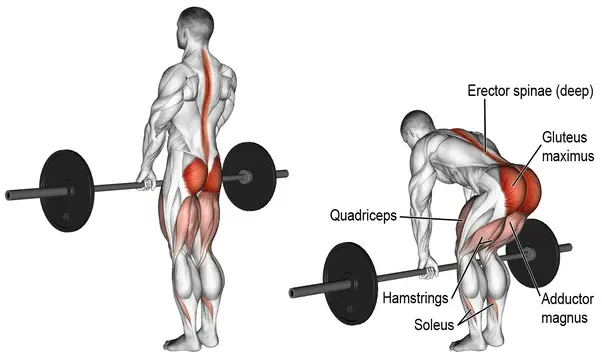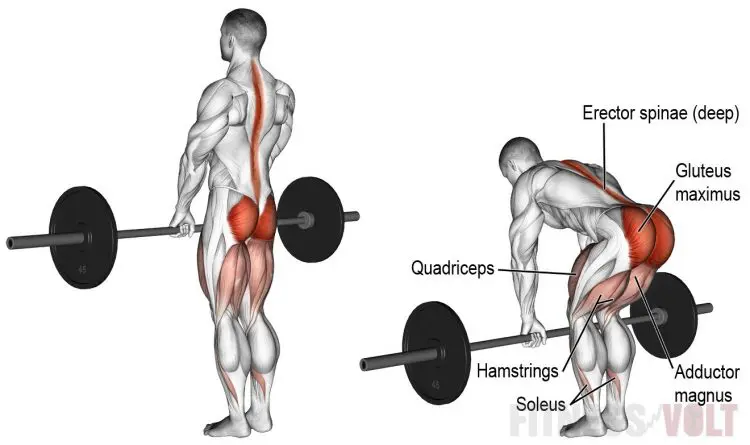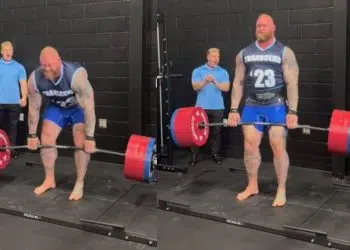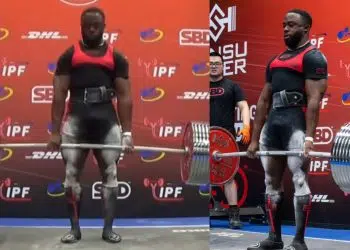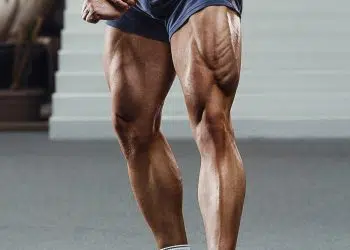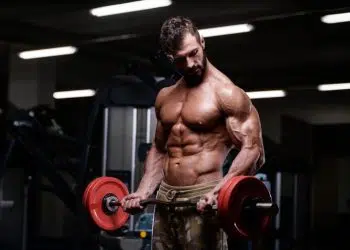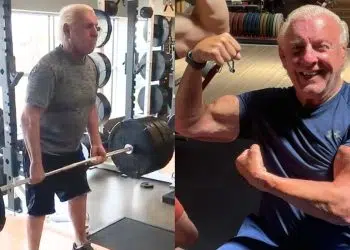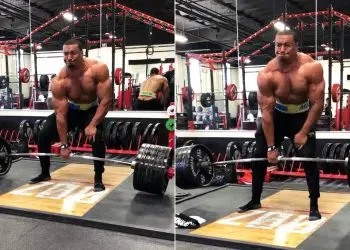If you could only do one exercise for the rest of your training life, which would you choose? Some of you reading this would pick bench presses, while smarter lifters would probably go for something more functional, like squats. However, the best option is arguably deadlifts.
Deadlifts are both functional and great for building posterior chain strength and size. You can even do deadlifts to burn fat and control your weight. They’re SUCH a versatile exercise!
However, there are several types of deadlifts, so you need to know how they differ so you can choose the best one for your goals.
In this article, we’re going to compare and contrast conventional and Romanian deadlifts.
Conventional Deadlift 101
The conventional or regular deadlift is something of a workout staple. Bodybuilders do it to build a bigger, more muscular back, while for powerlifters, it’s a test of posterior chain strength. The conventional deadlift also teaches you how to safely lift heavy objects off the floor, i.e., using your legs and without rounding your lower back. Almost every exerciser should do conventional deadlifts; they’re THAT important.
Muscles worked
Deadlifts are a compound exercise, which means they involve two or more joints working simultaneously. The main muscles involved in conventional deadlifts are:
Level Up Your Fitness: Join our 💪 strong community in Fitness Volt Newsletter. Get daily inspiration, expert-backed workouts, nutrition tips, the latest in strength sports, and the support you need to reach your goals. Subscribe for free!
- Gastrocnemius and soleus – calf muscles
- Hamstrings – rear of the thigh
- Quadriceps – front of the thigh
- Gluteus maximus – bottom/butt muscles
- Erector spine – muscles on either side of your spine
- Core muscles – deep muscles surrounding your internal organs
- Rhomboids and trapezius – muscles of the upper back
- Latissimus dorsi – side upper back muscles
- Deltoids – muscles of the shoulder
- Biceps and triceps – front and back of the upper arm
- Forearm flexors – gripping muscles
Conventional deadlifts are generally done using a barbell but can also be done with dumbbells.
How to do conventional deadlifts:
- Set your barbell, so it’s nine inches above the floor. Using bumper plates usually does this automatically.
- Stand with your toes under the bar, feet about hip to shoulder-width apart.
- Reach down and grip the bar with an overhand or mixed grip.
- Straighten your arms, pull your shoulders down and back, and brace your abs. Your hips should be below your shoulders, and your lower back slightly arched.
- Without bending your arms or rounding your lower back, drive your feet into the floor and stand up.
- Do not lean back at the top or attempt to bend your elbows, as this can cause serious injury.
- Push your hips back, bend your knees, and lower the bar back to the floor.
- Let the weight settle for a second or two, and then repeat. Do not bounce the bar off the floor.
Read more about deadlifting with perfect form here.
Conventional Deadlift Pros
There are several reasons that conventional deadlifts deserve a place in your workouts, including:
A truly functional exercise – functional exercises mimic the activities and movements of sports and daily living. Conventional deadlifts involve lifting a heavy object off the floor, which is about as functional as exercises get. They also teach you to lift heavy objects safely, reducing your risk of back injury outside the gym.
A full-body workout – conventional deadlifts work almost every muscle in your body. In fact, the only muscles not directly involved in conventional deadlifts are your pecs. This shortfall is easily remedied by doing push-ups between sets of deadlifts for a short and sharp full-body workout.
A bigger, more muscular back – bodybuilders do deadlifts to build a more massive back, and powerlifters have huge backs because of deadlifts. Lat pulldowns, pull-ups, and bent-over rows are all decent back builders. Still, conventional deadlifts are arguably the most efficient way to make your back thicker and broader.
Accessible – all you need to do conventional deadlifts is a barbell and some weight plates. As such, you can do this exercise in even the most sparsely equipped gym. No barbell? You can also do deadlifts using dumbbells, or even a heavy rock, backpack, or similar.
Safe – if you train to failure with deadlifts, you can simply drop the weight on the floor if you cannot complete a rep. In contrast, with squats and bench presses, if you can’t lock out, there is a very real risk of serious injury.
Conventional Deadlift Cons
Like every exercise, there are a few cons to doing conventional deadlifts, too:
Risk of lower back injury – done with good form, the conventional deadlift should help you build a more muscular, healthier back. But deadlifts done with poor form can cause serious back injury. The biggest conventional deadlift sin is lifting with a rounded lumbar spine. This puts a tremendous amount of stress on the intervertebral ligaments and discs, which, if injured, can take a long time to heal.
Equipment – a well-performed deadlift starts with a decent barbell set to the right height, usually about nine inches above the floor. This height is easy to achieve if you use Olympic bumper plates but more challenging if you use standard fitness weight plates. A bar with a bit of flex is also helpful, especially if you are lifting heavy weights. For that reason, there are bars made specifically for deadlifts.
Grip issues – you need strong hands to do conventional deadlifts. If your grip weakens mid-set, you’ll have to stop before your main muscles are fatigued. You can use lifting straps to bolster a weak grip, and a lot of lifters use a mixed grip, which stops the bar from rolling out of your fingers. However, if you have small hands, short fingers, or a weak grip, you may find deadlifts overly challenging.
Romanian Deadlift 101
Legend has it that the Romanian deadlift got its name when American Olympic weightlifting coaches watched a group of Romanian lifters training. At the time, Romania was a dominating force in weightlifting, and Romanian lifters used this exercise to increase hamstring, glute, and lower back strength.
Believing they’d uncovered a “secret” exercise, the US coaches took the now-called Romanian deadlifts and introduced it to their lifters. It quickly became a popular exercise with athletes from all sports, including bodybuilding.
The Romanian deadlift is a lot like the stiff-legged deadlift. The main difference is that the Romanian variation is done with slightly bent knees, making it a little more lower back-friendly while increasing glute activation.
Unlike conventional deadlifts, Romanian deadlifts are more of an isolation exercise because they only involve significant movement at one joint – the hips. However, they still involve a lot of different muscle groups.
Muscles worked
The main muscles involved in Romanian deadlifts are:
- Hamstrings – rear of the thigh
- Gluteus maximus – bottom/butt muscles
- Erector spine – muscles on either side of your spine
- Core muscles – deep muscles surrounding your internal organs
- Rhomboids and trapezius – muscles of the upper back
- Latissimus dorsi – side upper back muscles
- Deltoids – muscles of the shoulder
- Biceps and triceps – front and back of the upper arm
- Forearm flexors – gripping muscles
Like conventional deadlifts, Romanian deadlifts are normally done using a barbell but can also be done with dumbbells.
How to do Romanian deadlifts:
- Hold your barbell with a shoulder-width, overhand or mixed grip. Stand with your feet about shoulder to hip-width apart. Pull your shoulders down and back, brace your core, and bend your knees slightly.
- Without bending your legs much further, push your butt back and lean forward from your hips, taking care not to round your lower back. Keep your neck aligned with the rest of your spine as you lean over.
- Descend as far as your flexibility allows. The weight should not touch the floor.
- Drive your hips forward again and stand up straight. Do not lean back at the top of the movement.
Read more about Romanian deadlifts and their performance here.
Romanian Deadlift Pros
Not sure if Romanian deadlifts deserve a place in your workouts? Consider these benefits:
One of the best posterior chain exercises around – conventional deadlifts work your entire body. Still, Romanian deadlifts focus more on your glutes, hamstrings, and lower back, which are collectively known as your posterior chain. These muscles play a crucial part in your appearance and sporting performance. If you want to beef up your posterior chain, Romanian deadlifts are a great choice.
You don’t need a special bar to do them – any old barbell will do for Romanian deadlifts. The size of your weight plates doesn’t matter, either. As such, for most lifters, Romanian deadlifts are potentially more accessible.
Potentially more spine-friendly – when you do conventional deadlifts, each rep starts from the floor. Bending down to grab the bar requires good mobility and flexibility. Some people find it hard to get into the correct starting position and end up rounding their lower back.
Level Up Your Fitness: Join our 💪 strong community in Fitness Volt Newsletter. Get daily inspiration, expert-backed workouts, nutrition tips, the latest in strength sports, and the support you need to reach your goals. Subscribe for free!
Romanian deadlifts start from standing, and you only need to lean as far forward as your flexibility allows. As such, the chances of rounding your lower back are smaller. Start your set by lifting the barbell off a squat rack set to mid-thigh height to completely avoid having to set the bar on the floor.
Romanian Deadlift Cons
There are a few cons to doing Romanian deadlifts, too:
Tight hamstrings will limit your range of motion – keeping your legs semi-straight means that you may not be able to lean very far forward without rounding your lower back. A shorter range of motion could make this exercise less effective. Ideally, you should be able to lower the bar to just below knee height.
Grip issues – like conventional deadlifts, lack of grip strength could bring your set to a premature end. Using lifting straps will help, but if your hands give out before your posterior chain, your workout won’t be as productive as it could be. If lack of grip strength limits your workout performance, you may be better off doing barbell hip thrusts or another exercise that doesn’t involve your hands.
Romanian Deadlift Vs. Conventional Deadlift
So, now that you know a little more about conventional and Romanian deadlifts, let’s judge these exercises by a few different criteria:
Romanian Deadlift Vs. Conventional Deadlift: Strength
While it is possible to lift some impressively heavy weights with Romanian deadlifts, conventional deadlifts are the best exercise for building brute strength. Starting each rep with the weight on the floor means you can use heavier loads. You can also lower the weight relatively quickly, saving energy for your next pull.
Because of this, powerlifters and strongman competitors develop and test their strength with conventional deadlifts rather than Romanian deadlifts.
Winner: Conventional deadlift
Romanian Deadlift Vs. Conventional Deadlift: Hypertrophy
Bodybuilders train specifically for hypertrophy or muscle growth. Many include conventional AND Romanian deadlifts in their workouts. As such, it’s a safe bet that both types of deadlift can build muscle mass.
That said, because the movements are different, each exercise increases muscle size in different parts of your body.
Conventional deadlifts work and build your entire body, with an emphasis on the muscles of the back – lower and upper. Bodybuilders tend to do conventional deadlifts on back training day.
In contrast, Romanian deadlifts are usually done on leg day, as they are an excellent exercise for the hamstrings and glutes.
So, in short, both types of deadlift can build muscle, but they work different muscle groups, so pick the right one for the body part you want to train.
Winner: Conventional deadlift for back, but Romanian deadlift for your legs and glutes.
Romanian Deadlift Vs. Conventional Deadlift: Long-term progression
There are a few ways you can make conventional and Romanian deadlifts harder so that you continue making long-term progress. You can do more reps with the same weight, do more sets, take less rest between sets, or lift more weight.
In all likelihood, you’ll be able to increase your weights for longer with conventional deadlifts. Most people can conventional deadlift more than they can Romanian deadlift. As such, your Romanian deadlift progress is likely to stall first.
However, in reality, very few people ever reach their genetic potential for any exercise, making this comparison somewhat irrelevant. Most people should be able to keep making progress in both types of deadlift for many years to come.
Winner: Conventional deadlift, but only just!
Romanian Deadlift Vs. Conventional Deadlift: Variety
One of the best ways to avoid progress plateaus is to change your workout from time to time and use variations of your main exercises. In many cases, simply altering the width of your grip or angle of your arms is all that’s needed to avoid workout ruts.
You can do Romanian deadlifts using a barbell, dumbbells, trap bar, or one-legged. Still, there are more variations for the conventional deadlift, including:
- Dumbbell deadlift
- Sumo deadlift
- Deficit deadlift
- Rack pulls
- Paused deadlift
- Trap bar deadlift
- Snatch grip deadlift
- Reeves deadlift
- Partial deadlift
- Suitcase deadlift
Winner: Conventional deadlift
Romanian Deadlift Vs. Conventional Deadlift: Safety
Safety is an important consideration when choosing your exercises. Ideally, you want to pick the exercises that offer the greatest benefit for the least risk of injury. If the potential cost outweighs the benefits, you should probably choose a different exercise.
It’s not easy to compare the safety of conventional vs. Romanian deadlifts as both exercises could cause serious injury if performed incorrectly. However, because conventional deadlifts start from the floor, the need for good flexibility is higher than for Romanian deadlifts, which means they’re potentially riskier.
In reality, there isn’t much between these two exercises, and the main factor affecting safety is the user. For some people, conventional deadlifts will be safer than the Romanian variation, and for others, the reverse is true.
Winner: It’s a draw!
Romanian Deadlift Vs. Conventional Deadlift: Ease of learning
Conventional deadlifts involve a fairly commonplace, natural movement pattern. Most people do something akin to a deadlift whenever they bend down to pick something up from the floor. In contrast, the Romanian deadlift movement is a little less natural.
That said, Romanian deadlifts are a more straightforward movement that only really involves one joint; the hips. Conventional deadlifts are more complicated and require full-body coordination.
So, which one is easier to learn? It’s a close-run thing, but the answer is probably conventional deadlifts, as it’s something a lot of us do without thinking about it too much. Of course, there are technical considerations such as not letting your hips rise faster than your shoulders and keeping your lower back slightly arched. But the basic conventional deadlift movement should be something that most people already do.
Winner: Conventional deadlifts
Wrapping Up
Romanian and conventional deadlifts share some of the same benefits, but they’re actually two quite different exercises. Romanian deadlifts are MOSTLY a posterior chain exercise that works the lower body. In contrast, conventional deadlifts are more of a full-body exercise, emphasizing the lower and upper back. Yes, conventional deadlifts also work your legs, but that’s not why most people do them. After all, when it comes to lower body training, squats and leg presses would be a better choice.
So, rather than try and choose between these two excellent exercises, just do them both. Perform conventional deadlifts as part of your back workout and Romanian deadlifts when you train your legs. That way you can enjoy all the benefits of these two exercises.
However, because of the overlaps between Romanian and conventional deadlifts, you should probably do them a few days apart to avoid overtraining your lower back.
Interested in measuring your progress? Check out our strength standards for Bench Press, Push Ups, Stiff Leg Deadlift, and more.

